Deep Learning and Surface Learning Approaches in Higher Education
VerifiedAdded on 2021/06/14
|8
|1686
|157
Essay
AI Summary
This essay delves into the contrasting characteristics of deep and surface learning approaches, examining their implications within the context of higher education. It explores the evolution of learning approaches, including the strategic learning approach, and critiques the relevance of the Biggs model. The essay examines research on student learning, peer assessment, and the impact of problem-based learning. It highlights the importance of considering both deep and surface learning, emphasizing the need for a balanced approach. The study also examines the context of medical education, the challenges of imparting knowledge, and the differences in learning approaches between undergraduate and postgraduate students. It references several studies and models to support the arguments.
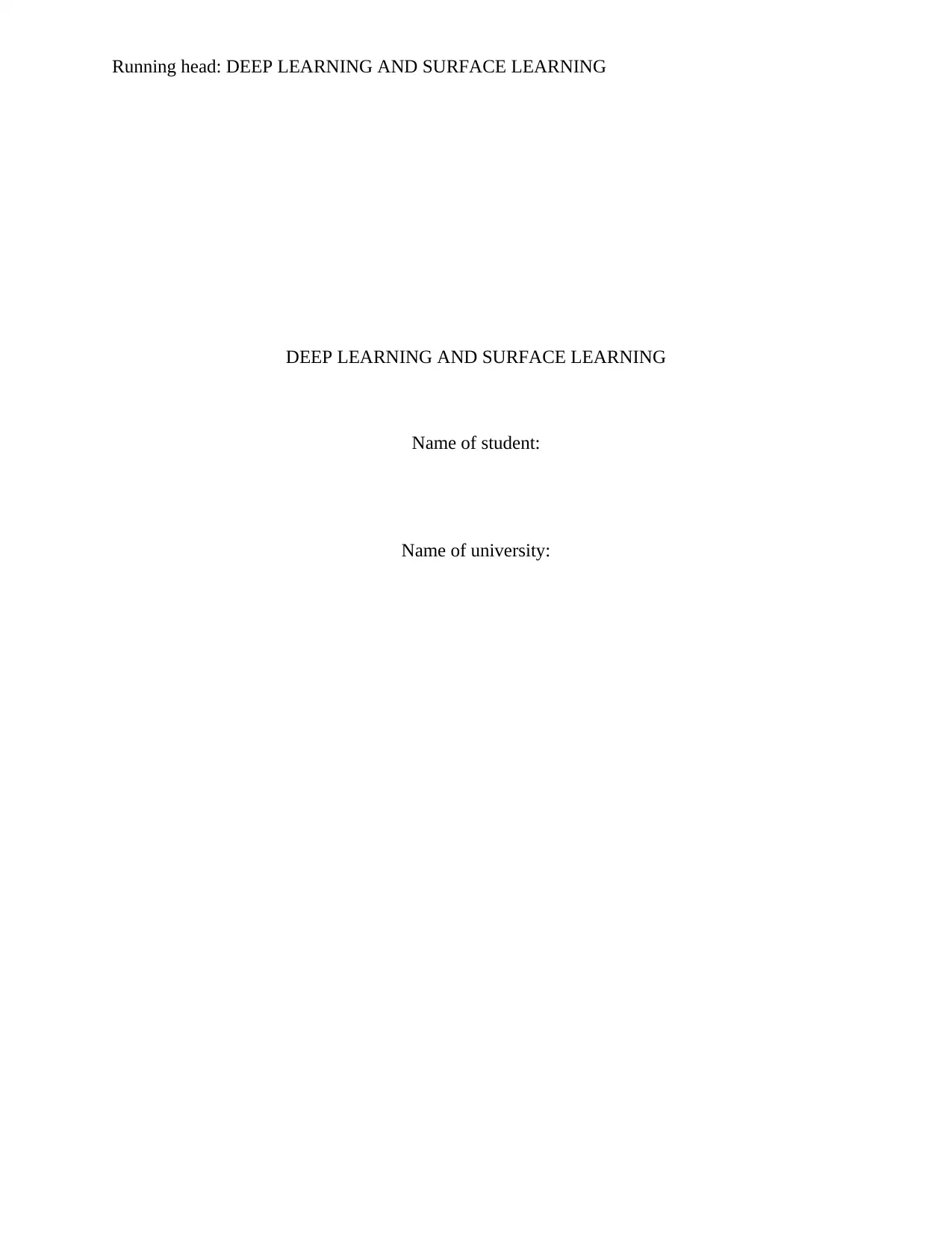
Running head: DEEP LEARNING AND SURFACE LEARNING
DEEP LEARNING AND SURFACE LEARNING
Name of student:
Name of university:
DEEP LEARNING AND SURFACE LEARNING
Name of student:
Name of university:
Paraphrase This Document
Need a fresh take? Get an instant paraphrase of this document with our AI Paraphraser
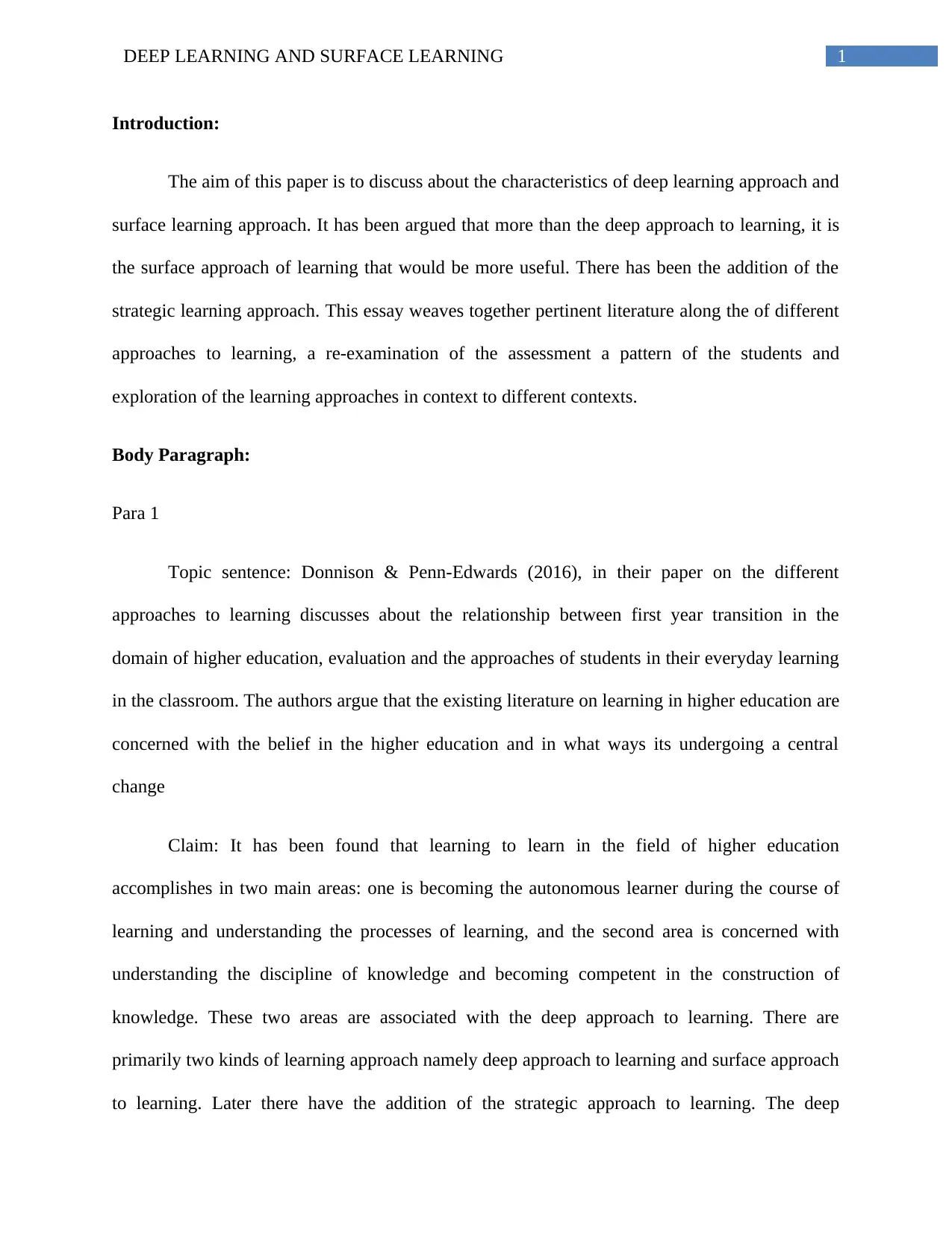
1DEEP LEARNING AND SURFACE LEARNING
Introduction:
The aim of this paper is to discuss about the characteristics of deep learning approach and
surface learning approach. It has been argued that more than the deep approach to learning, it is
the surface approach of learning that would be more useful. There has been the addition of the
strategic learning approach. This essay weaves together pertinent literature along the of different
approaches to learning, a re-examination of the assessment a pattern of the students and
exploration of the learning approaches in context to different contexts.
Body Paragraph:
Para 1
Topic sentence: Donnison & Penn-Edwards (2016), in their paper on the different
approaches to learning discusses about the relationship between first year transition in the
domain of higher education, evaluation and the approaches of students in their everyday learning
in the classroom. The authors argue that the existing literature on learning in higher education are
concerned with the belief in the higher education and in what ways its undergoing a central
change
Claim: It has been found that learning to learn in the field of higher education
accomplishes in two main areas: one is becoming the autonomous learner during the course of
learning and understanding the processes of learning, and the second area is concerned with
understanding the discipline of knowledge and becoming competent in the construction of
knowledge. These two areas are associated with the deep approach to learning. There are
primarily two kinds of learning approach namely deep approach to learning and surface approach
to learning. Later there have the addition of the strategic approach to learning. The deep
Introduction:
The aim of this paper is to discuss about the characteristics of deep learning approach and
surface learning approach. It has been argued that more than the deep approach to learning, it is
the surface approach of learning that would be more useful. There has been the addition of the
strategic learning approach. This essay weaves together pertinent literature along the of different
approaches to learning, a re-examination of the assessment a pattern of the students and
exploration of the learning approaches in context to different contexts.
Body Paragraph:
Para 1
Topic sentence: Donnison & Penn-Edwards (2016), in their paper on the different
approaches to learning discusses about the relationship between first year transition in the
domain of higher education, evaluation and the approaches of students in their everyday learning
in the classroom. The authors argue that the existing literature on learning in higher education are
concerned with the belief in the higher education and in what ways its undergoing a central
change
Claim: It has been found that learning to learn in the field of higher education
accomplishes in two main areas: one is becoming the autonomous learner during the course of
learning and understanding the processes of learning, and the second area is concerned with
understanding the discipline of knowledge and becoming competent in the construction of
knowledge. These two areas are associated with the deep approach to learning. There are
primarily two kinds of learning approach namely deep approach to learning and surface approach
to learning. Later there have the addition of the strategic approach to learning. The deep
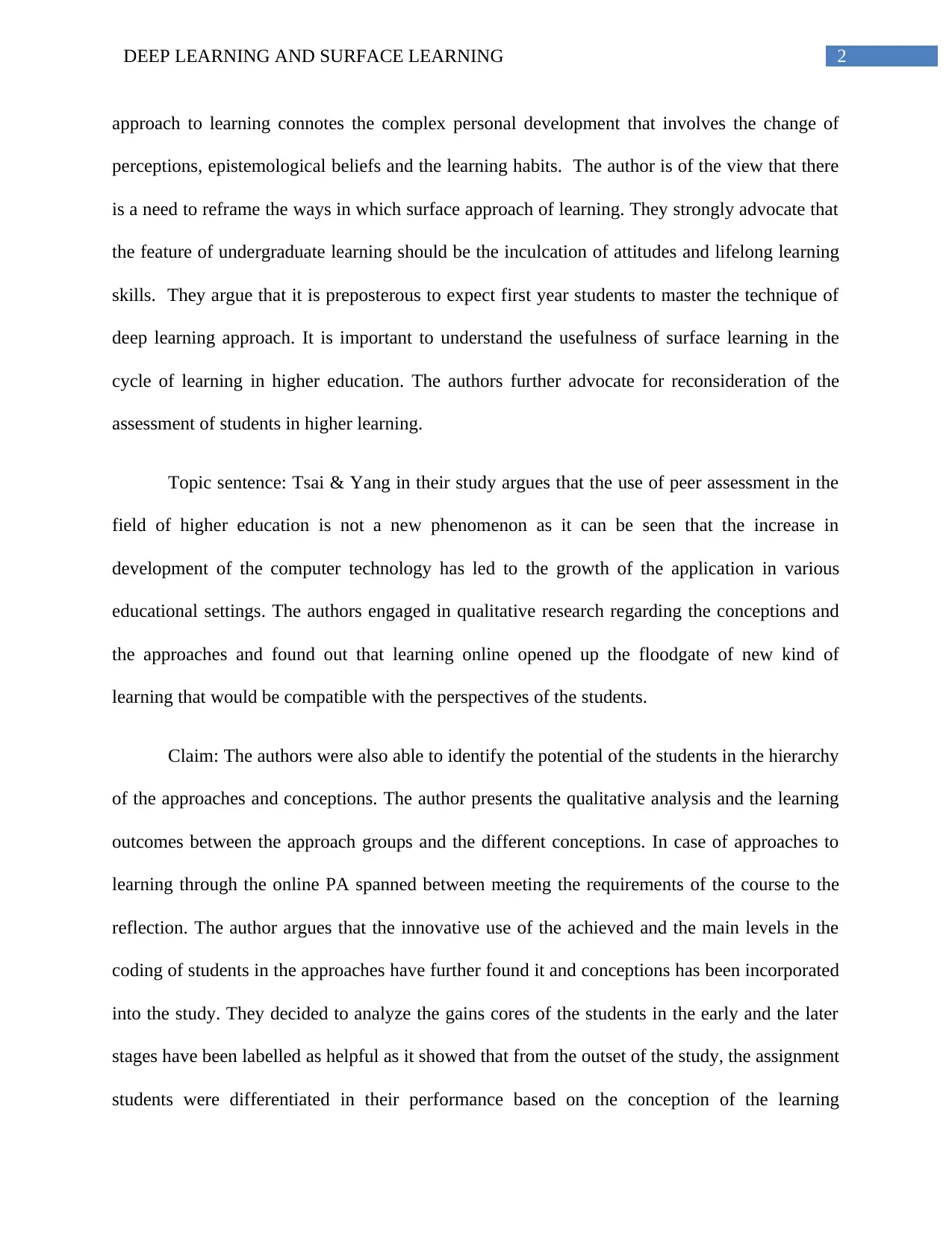
2DEEP LEARNING AND SURFACE LEARNING
approach to learning connotes the complex personal development that involves the change of
perceptions, epistemological beliefs and the learning habits. The author is of the view that there
is a need to reframe the ways in which surface approach of learning. They strongly advocate that
the feature of undergraduate learning should be the inculcation of attitudes and lifelong learning
skills. They argue that it is preposterous to expect first year students to master the technique of
deep learning approach. It is important to understand the usefulness of surface learning in the
cycle of learning in higher education. The authors further advocate for reconsideration of the
assessment of students in higher learning.
Topic sentence: Tsai & Yang in their study argues that the use of peer assessment in the
field of higher education is not a new phenomenon as it can be seen that the increase in
development of the computer technology has led to the growth of the application in various
educational settings. The authors engaged in qualitative research regarding the conceptions and
the approaches and found out that learning online opened up the floodgate of new kind of
learning that would be compatible with the perspectives of the students.
Claim: The authors were also able to identify the potential of the students in the hierarchy
of the approaches and conceptions. The author presents the qualitative analysis and the learning
outcomes between the approach groups and the different conceptions. In case of approaches to
learning through the online PA spanned between meeting the requirements of the course to the
reflection. The author argues that the innovative use of the achieved and the main levels in the
coding of students in the approaches have further found it and conceptions has been incorporated
into the study. They decided to analyze the gains cores of the students in the early and the later
stages have been labelled as helpful as it showed that from the outset of the study, the assignment
students were differentiated in their performance based on the conception of the learning
approach to learning connotes the complex personal development that involves the change of
perceptions, epistemological beliefs and the learning habits. The author is of the view that there
is a need to reframe the ways in which surface approach of learning. They strongly advocate that
the feature of undergraduate learning should be the inculcation of attitudes and lifelong learning
skills. They argue that it is preposterous to expect first year students to master the technique of
deep learning approach. It is important to understand the usefulness of surface learning in the
cycle of learning in higher education. The authors further advocate for reconsideration of the
assessment of students in higher learning.
Topic sentence: Tsai & Yang in their study argues that the use of peer assessment in the
field of higher education is not a new phenomenon as it can be seen that the increase in
development of the computer technology has led to the growth of the application in various
educational settings. The authors engaged in qualitative research regarding the conceptions and
the approaches and found out that learning online opened up the floodgate of new kind of
learning that would be compatible with the perspectives of the students.
Claim: The authors were also able to identify the potential of the students in the hierarchy
of the approaches and conceptions. The author presents the qualitative analysis and the learning
outcomes between the approach groups and the different conceptions. In case of approaches to
learning through the online PA spanned between meeting the requirements of the course to the
reflection. The author argues that the innovative use of the achieved and the main levels in the
coding of students in the approaches have further found it and conceptions has been incorporated
into the study. They decided to analyze the gains cores of the students in the early and the later
stages have been labelled as helpful as it showed that from the outset of the study, the assignment
students were differentiated in their performance based on the conception of the learning
⊘ This is a preview!⊘
Do you want full access?
Subscribe today to unlock all pages.

Trusted by 1+ million students worldwide
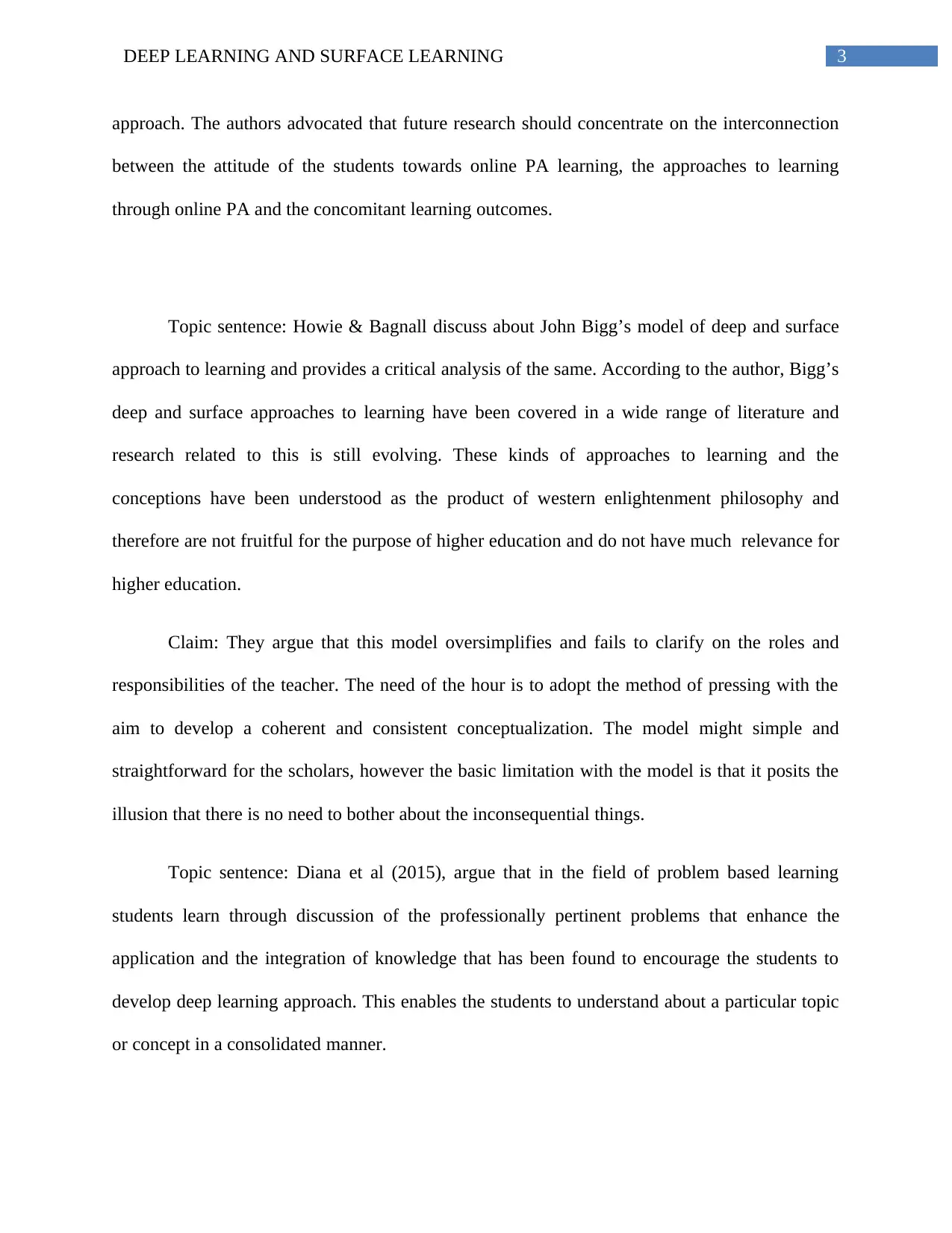
3DEEP LEARNING AND SURFACE LEARNING
approach. The authors advocated that future research should concentrate on the interconnection
between the attitude of the students towards online PA learning, the approaches to learning
through online PA and the concomitant learning outcomes.
Topic sentence: Howie & Bagnall discuss about John Bigg’s model of deep and surface
approach to learning and provides a critical analysis of the same. According to the author, Bigg’s
deep and surface approaches to learning have been covered in a wide range of literature and
research related to this is still evolving. These kinds of approaches to learning and the
conceptions have been understood as the product of western enlightenment philosophy and
therefore are not fruitful for the purpose of higher education and do not have much relevance for
higher education.
Claim: They argue that this model oversimplifies and fails to clarify on the roles and
responsibilities of the teacher. The need of the hour is to adopt the method of pressing with the
aim to develop a coherent and consistent conceptualization. The model might simple and
straightforward for the scholars, however the basic limitation with the model is that it posits the
illusion that there is no need to bother about the inconsequential things.
Topic sentence: Diana et al (2015), argue that in the field of problem based learning
students learn through discussion of the professionally pertinent problems that enhance the
application and the integration of knowledge that has been found to encourage the students to
develop deep learning approach. This enables the students to understand about a particular topic
or concept in a consolidated manner.
approach. The authors advocated that future research should concentrate on the interconnection
between the attitude of the students towards online PA learning, the approaches to learning
through online PA and the concomitant learning outcomes.
Topic sentence: Howie & Bagnall discuss about John Bigg’s model of deep and surface
approach to learning and provides a critical analysis of the same. According to the author, Bigg’s
deep and surface approaches to learning have been covered in a wide range of literature and
research related to this is still evolving. These kinds of approaches to learning and the
conceptions have been understood as the product of western enlightenment philosophy and
therefore are not fruitful for the purpose of higher education and do not have much relevance for
higher education.
Claim: They argue that this model oversimplifies and fails to clarify on the roles and
responsibilities of the teacher. The need of the hour is to adopt the method of pressing with the
aim to develop a coherent and consistent conceptualization. The model might simple and
straightforward for the scholars, however the basic limitation with the model is that it posits the
illusion that there is no need to bother about the inconsequential things.
Topic sentence: Diana et al (2015), argue that in the field of problem based learning
students learn through discussion of the professionally pertinent problems that enhance the
application and the integration of knowledge that has been found to encourage the students to
develop deep learning approach. This enables the students to understand about a particular topic
or concept in a consolidated manner.
Paraphrase This Document
Need a fresh take? Get an instant paraphrase of this document with our AI Paraphraser
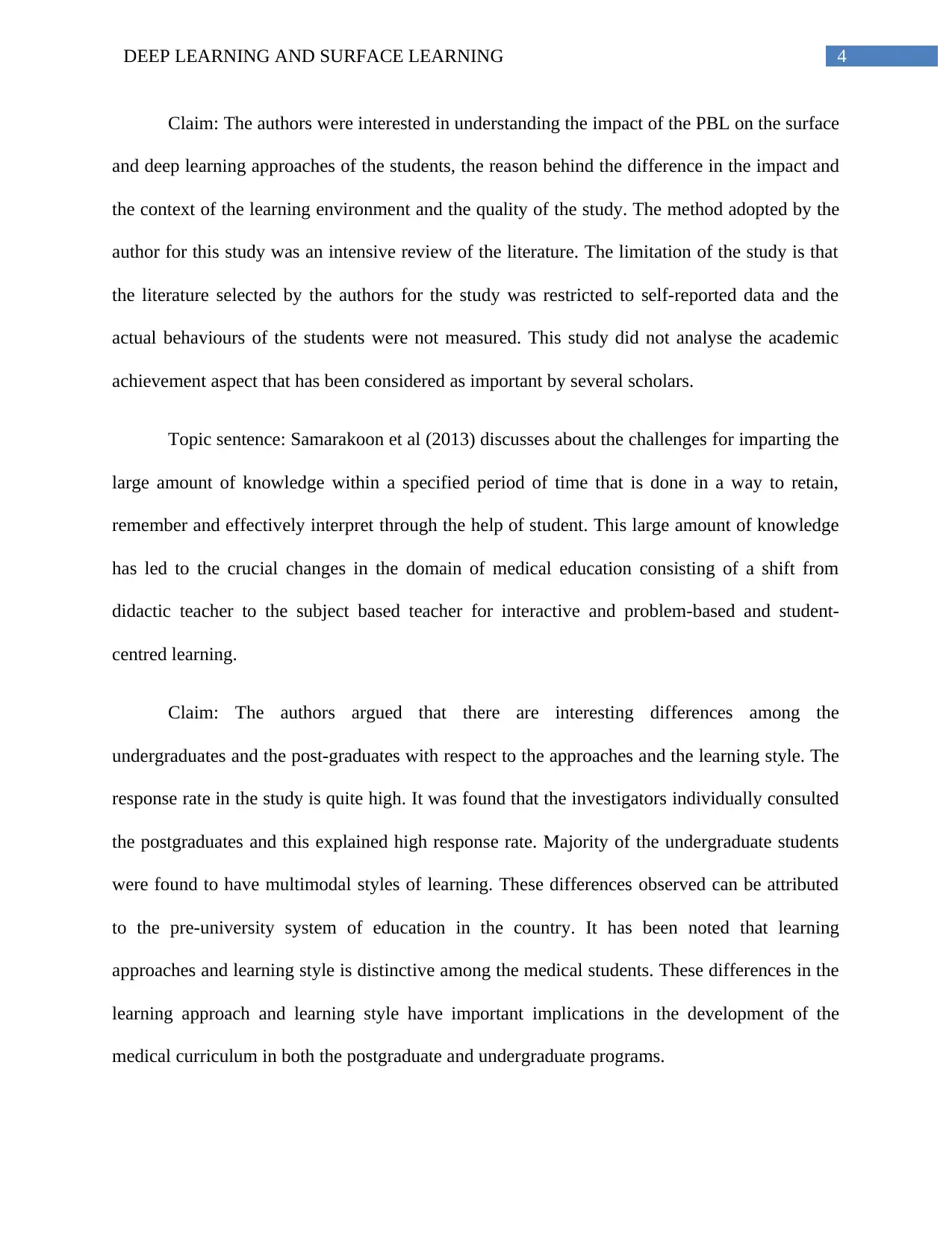
4DEEP LEARNING AND SURFACE LEARNING
Claim: The authors were interested in understanding the impact of the PBL on the surface
and deep learning approaches of the students, the reason behind the difference in the impact and
the context of the learning environment and the quality of the study. The method adopted by the
author for this study was an intensive review of the literature. The limitation of the study is that
the literature selected by the authors for the study was restricted to self-reported data and the
actual behaviours of the students were not measured. This study did not analyse the academic
achievement aspect that has been considered as important by several scholars.
Topic sentence: Samarakoon et al (2013) discusses about the challenges for imparting the
large amount of knowledge within a specified period of time that is done in a way to retain,
remember and effectively interpret through the help of student. This large amount of knowledge
has led to the crucial changes in the domain of medical education consisting of a shift from
didactic teacher to the subject based teacher for interactive and problem-based and student-
centred learning.
Claim: The authors argued that there are interesting differences among the
undergraduates and the post-graduates with respect to the approaches and the learning style. The
response rate in the study is quite high. It was found that the investigators individually consulted
the postgraduates and this explained high response rate. Majority of the undergraduate students
were found to have multimodal styles of learning. These differences observed can be attributed
to the pre-university system of education in the country. It has been noted that learning
approaches and learning style is distinctive among the medical students. These differences in the
learning approach and learning style have important implications in the development of the
medical curriculum in both the postgraduate and undergraduate programs.
Claim: The authors were interested in understanding the impact of the PBL on the surface
and deep learning approaches of the students, the reason behind the difference in the impact and
the context of the learning environment and the quality of the study. The method adopted by the
author for this study was an intensive review of the literature. The limitation of the study is that
the literature selected by the authors for the study was restricted to self-reported data and the
actual behaviours of the students were not measured. This study did not analyse the academic
achievement aspect that has been considered as important by several scholars.
Topic sentence: Samarakoon et al (2013) discusses about the challenges for imparting the
large amount of knowledge within a specified period of time that is done in a way to retain,
remember and effectively interpret through the help of student. This large amount of knowledge
has led to the crucial changes in the domain of medical education consisting of a shift from
didactic teacher to the subject based teacher for interactive and problem-based and student-
centred learning.
Claim: The authors argued that there are interesting differences among the
undergraduates and the post-graduates with respect to the approaches and the learning style. The
response rate in the study is quite high. It was found that the investigators individually consulted
the postgraduates and this explained high response rate. Majority of the undergraduate students
were found to have multimodal styles of learning. These differences observed can be attributed
to the pre-university system of education in the country. It has been noted that learning
approaches and learning style is distinctive among the medical students. These differences in the
learning approach and learning style have important implications in the development of the
medical curriculum in both the postgraduate and undergraduate programs.
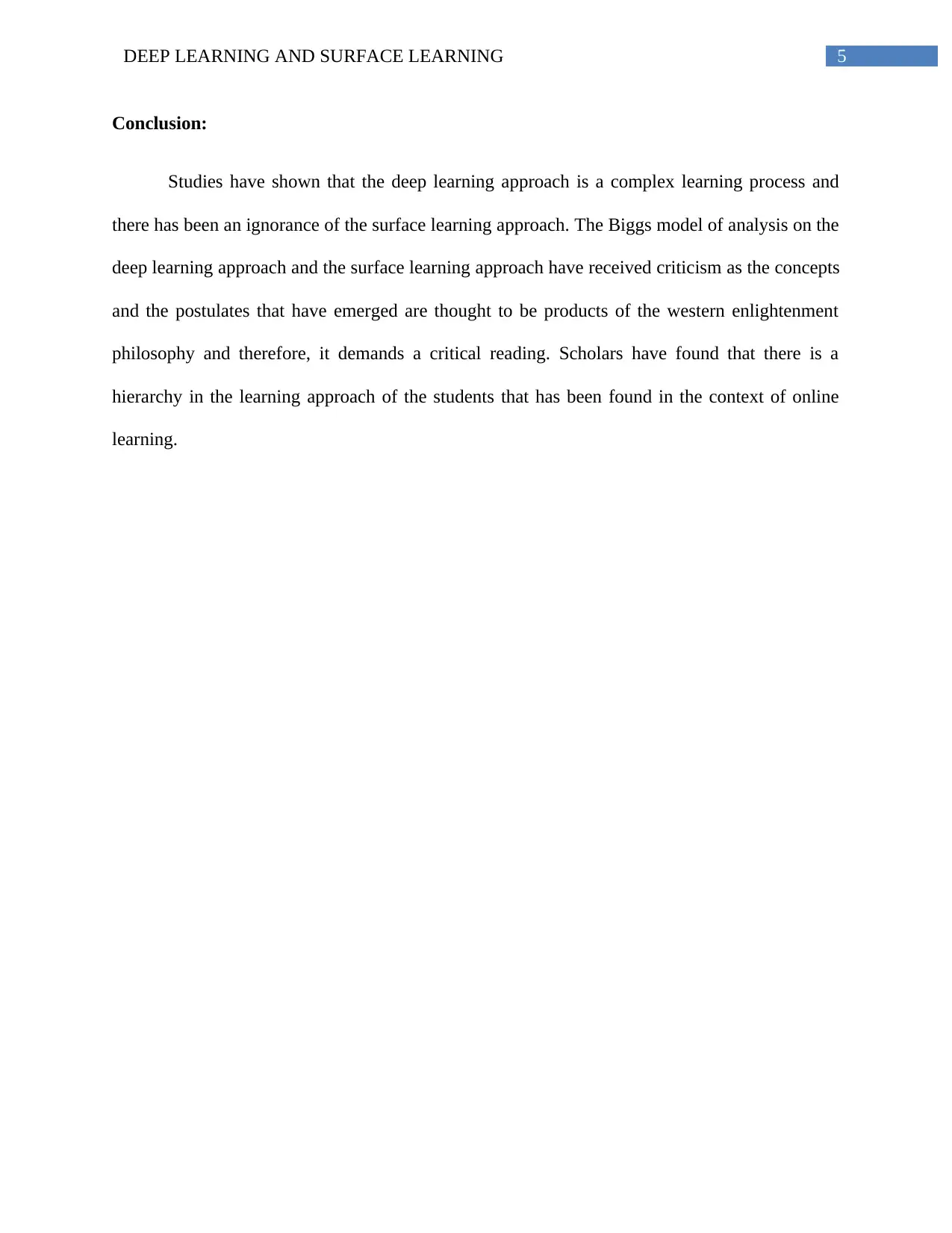
5DEEP LEARNING AND SURFACE LEARNING
Conclusion:
Studies have shown that the deep learning approach is a complex learning process and
there has been an ignorance of the surface learning approach. The Biggs model of analysis on the
deep learning approach and the surface learning approach have received criticism as the concepts
and the postulates that have emerged are thought to be products of the western enlightenment
philosophy and therefore, it demands a critical reading. Scholars have found that there is a
hierarchy in the learning approach of the students that has been found in the context of online
learning.
Conclusion:
Studies have shown that the deep learning approach is a complex learning process and
there has been an ignorance of the surface learning approach. The Biggs model of analysis on the
deep learning approach and the surface learning approach have received criticism as the concepts
and the postulates that have emerged are thought to be products of the western enlightenment
philosophy and therefore, it demands a critical reading. Scholars have found that there is a
hierarchy in the learning approach of the students that has been found in the context of online
learning.
⊘ This is a preview!⊘
Do you want full access?
Subscribe today to unlock all pages.

Trusted by 1+ million students worldwide
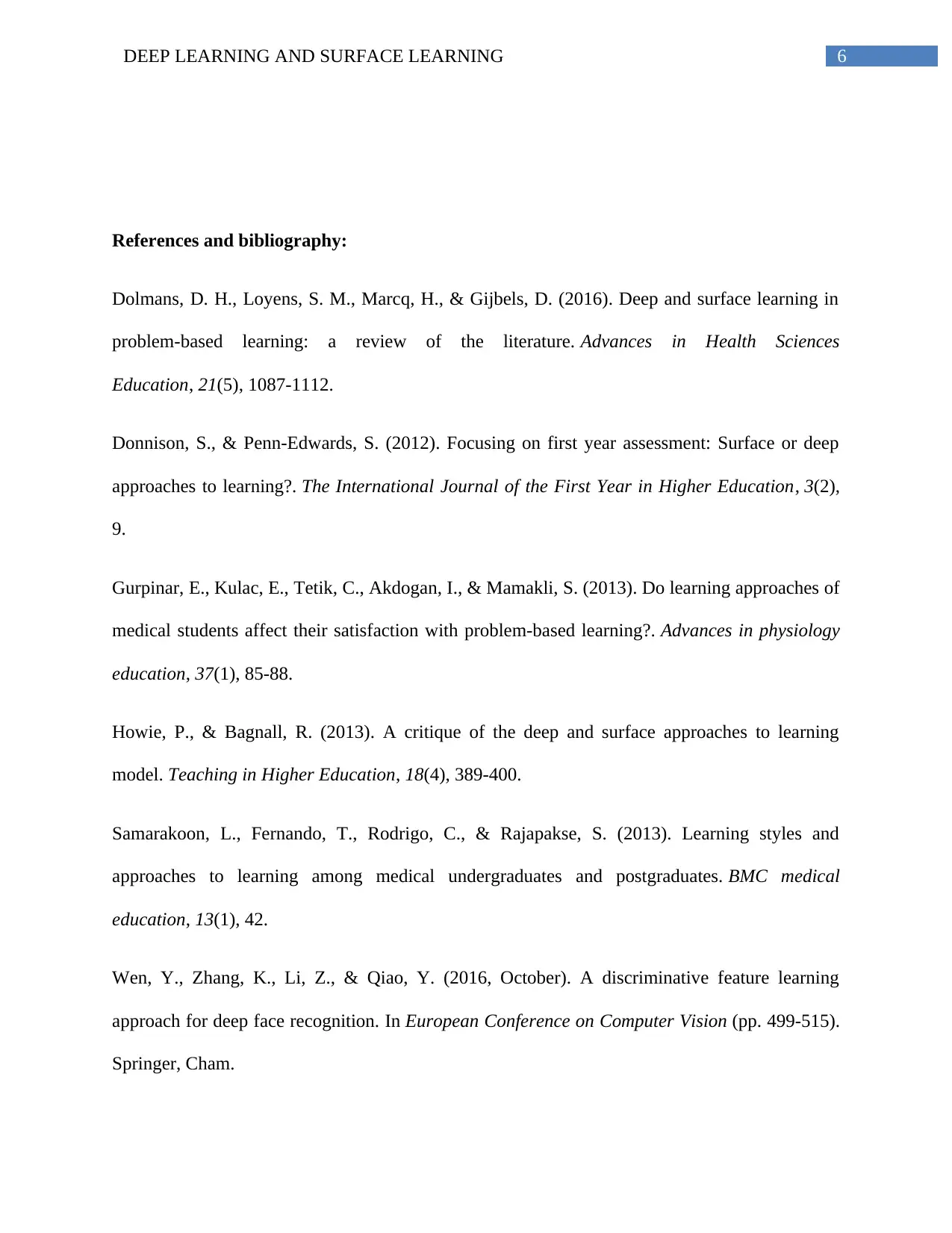
6DEEP LEARNING AND SURFACE LEARNING
References and bibliography:
Dolmans, D. H., Loyens, S. M., Marcq, H., & Gijbels, D. (2016). Deep and surface learning in
problem-based learning: a review of the literature. Advances in Health Sciences
Education, 21(5), 1087-1112.
Donnison, S., & Penn-Edwards, S. (2012). Focusing on first year assessment: Surface or deep
approaches to learning?. The International Journal of the First Year in Higher Education, 3(2),
9.
Gurpinar, E., Kulac, E., Tetik, C., Akdogan, I., & Mamakli, S. (2013). Do learning approaches of
medical students affect their satisfaction with problem-based learning?. Advances in physiology
education, 37(1), 85-88.
Howie, P., & Bagnall, R. (2013). A critique of the deep and surface approaches to learning
model. Teaching in Higher Education, 18(4), 389-400.
Samarakoon, L., Fernando, T., Rodrigo, C., & Rajapakse, S. (2013). Learning styles and
approaches to learning among medical undergraduates and postgraduates. BMC medical
education, 13(1), 42.
Wen, Y., Zhang, K., Li, Z., & Qiao, Y. (2016, October). A discriminative feature learning
approach for deep face recognition. In European Conference on Computer Vision (pp. 499-515).
Springer, Cham.
References and bibliography:
Dolmans, D. H., Loyens, S. M., Marcq, H., & Gijbels, D. (2016). Deep and surface learning in
problem-based learning: a review of the literature. Advances in Health Sciences
Education, 21(5), 1087-1112.
Donnison, S., & Penn-Edwards, S. (2012). Focusing on first year assessment: Surface or deep
approaches to learning?. The International Journal of the First Year in Higher Education, 3(2),
9.
Gurpinar, E., Kulac, E., Tetik, C., Akdogan, I., & Mamakli, S. (2013). Do learning approaches of
medical students affect their satisfaction with problem-based learning?. Advances in physiology
education, 37(1), 85-88.
Howie, P., & Bagnall, R. (2013). A critique of the deep and surface approaches to learning
model. Teaching in Higher Education, 18(4), 389-400.
Samarakoon, L., Fernando, T., Rodrigo, C., & Rajapakse, S. (2013). Learning styles and
approaches to learning among medical undergraduates and postgraduates. BMC medical
education, 13(1), 42.
Wen, Y., Zhang, K., Li, Z., & Qiao, Y. (2016, October). A discriminative feature learning
approach for deep face recognition. In European Conference on Computer Vision (pp. 499-515).
Springer, Cham.
Paraphrase This Document
Need a fresh take? Get an instant paraphrase of this document with our AI Paraphraser
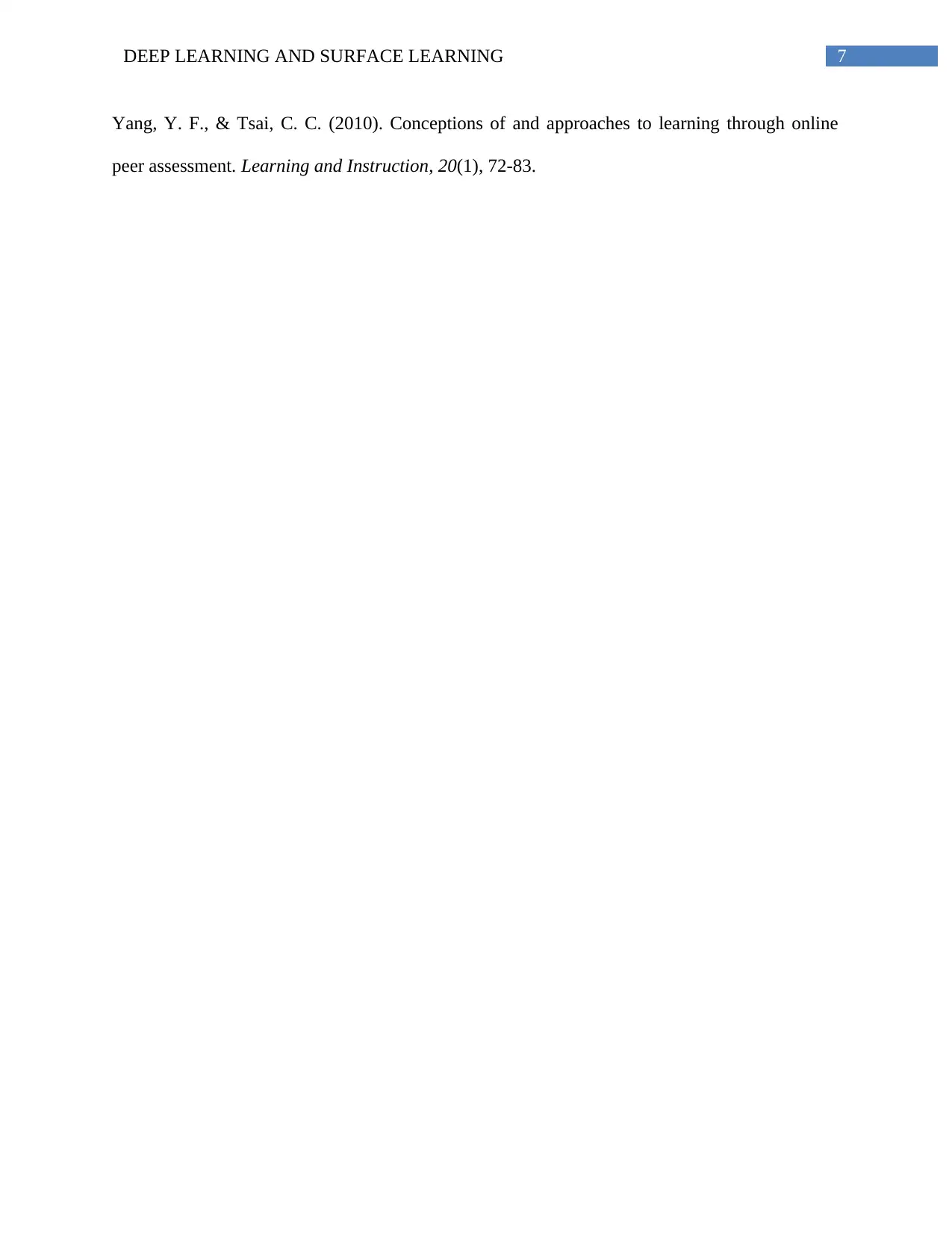
7DEEP LEARNING AND SURFACE LEARNING
Yang, Y. F., & Tsai, C. C. (2010). Conceptions of and approaches to learning through online
peer assessment. Learning and Instruction, 20(1), 72-83.
Yang, Y. F., & Tsai, C. C. (2010). Conceptions of and approaches to learning through online
peer assessment. Learning and Instruction, 20(1), 72-83.
1 out of 8
Related Documents
Your All-in-One AI-Powered Toolkit for Academic Success.
+13062052269
info@desklib.com
Available 24*7 on WhatsApp / Email
![[object Object]](/_next/static/media/star-bottom.7253800d.svg)
Unlock your academic potential
Copyright © 2020–2025 A2Z Services. All Rights Reserved. Developed and managed by ZUCOL.




